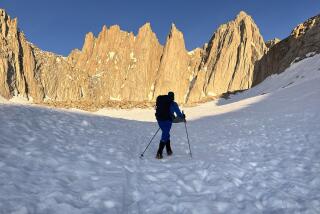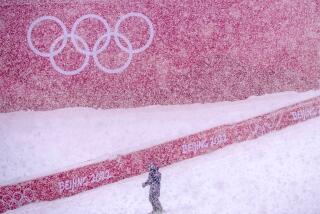Make tracks like Bigfoot in these shoes
- Share via
It may not pack the adrenaline rush or grace of popular winter sports such as downhill or Nordic skiing, but snowshoeing is a splendid way to leave machine-groomed trails behind and head for the wild terrain.
After a two-hour drive from Los Angeles, I found myself strapping on a pair of snowshoes and roaming the snow-covered woods of the San Bernardino National Forest. The winter forest, and all its tranquillity, had suddenly became accessible. I picked up and examined a frozen pine cone, knelt down to check out a set of small animal tracks (no big deal, a dog) and headed up a hillside for no purpose other than to see what was on the other side.
As I walked the forest with a couple of friendly snowshoe instructors from Green Valley Nordic, a winter sports business near Running Springs, the only sounds we heard were the crunch of snow beneath feet and our labored breathing.
Not only is walking on snow -- just two to three inches deep in most places -- hard work, but it’s considered a top-notch cardiovascular winter workout. Depending upon terrain, weight and speed, a snowshoer can burn 500 to 1,000 calories an hour -- more than 45% more than would be used walking or running at the same speed, according to a study by researchers at Ball State University and the University of Vermont.
Had the snow been deeper, a few feet instead of just inches as is not uncommon for local mountains in February and March, the workout would have been even tougher. It requires more energy to trudge through unpacked snow.
Snowshoeing wasn’t on my mind until a few months ago when my L.L. Bean catalog arrived in the mail, featuring some nifty-looking snowshoes. These weren’t the oversized tennis racket-like contraptions that I associated with guys like Sir Edmund Hillary, tromping around the frozen tundra.
Major advances in snowshoe designs, mostly in the late 1980s and early 1990s, helped to fuel a speedy ascent in the sport’s popularity. The old wood-framed shoes, still affectionately known as “woodies,” were heavy, clunky and hard to maneuver compared with today’s sleeker, lighter models, often made of aluminum.
Snowshoe sales increased more than 20% annually during the 1990s, and last year nearly 6 million Americans went snowshoeing, according to the Outdoor Industry of America, a trade group. Although people of just about any age can go snowshoeing, nearly 60% of participants are aged 16 to 34, according to the OIA.
Although snowshoeing requires no experience or lessons, I decided I needed a guide, since it was my first time out in unfamiliar terrain. I contacted Green Valley Nordic, which offers cross-country skiing and snowshoe lessons and rentals.
Because a photographer was coming along, too, they dispatched two guides, Sandy Grimes and Lya Van Den Oever, to make sure our outing went well. (The lessons were $30 an hour and the equipment rental was $15.)
I wore heavy fatigue pants and a T-shirt, a long-sleeve shirt and fleece sweater in preparation for the chilly weather, which was in the mid-40s in the early afternoon. Layering is strongly recommended for snowshoeing because as your body heats up, you’ll need to shed a piece or two. I took off the fleece sweater after about 15 minutes of our 55-minute trek.
The instructors provided us with cross-country ski boots, which needed three straps to be snugly secured in the snowshoes. The shoes themselves were about the size of an oval tennis racket, but had an aluminum frame with toe and heel crampons for good traction.
I had envisioned walking in snowshoes to be akin to walking in scuba flippers. But it wasn’t like that at all. While sprinting was not an option, the big moon steps I’d imagined were not necessary because of the well-designed snowshoes.
For extra balance, I opted to use ski poles, though neither Sandy nor Lya did. They planned to stick mostly to the flat trails, while I was eager to get up a few hillsides, for which poles are helpful.
From there, we marched into the snowy woods. Although the instructors were a nice insurance policy to have in case of trouble in an unfamiliar environment, I found they really weren’t necessary, even for a total beginner like me.
After mostly walking along level terrain, some of it icy, I slowly ventured up several hillsides. At an elevation of 7,000 feet, getting up the hills was a heart-pounding but rewarding experience. From the top of some hills, I had unspoiled and magnificent views of towns below.
Getting down hills was a bit tricky, and here’s where I was glad I had my poles. On more than one occasion, the poles helped me keep my balance and prevented a tumble down the hillside.
By the 40-minute mark, I was fairly tired and we started to make our way back to our cars. That’s another good feature about snowshoeing -- as long as it isn’t snowing, it’s almost impossible to get lost. You just follow your own tracks.
*
(BEGIN TEXT OF INFOBOX)
Snapshot: Snowshoeing
Duration of activity: 55 minutes
Calories burned*: 682
Heart rate*: Average, 134; high, 177
*This information was obtained using a heart-rate monitor.
*
Times staff writer Martin Miller can be reached at [email protected].
More to Read
Sign up for The Wild
We’ll help you find the best places to hike, bike and run, as well as the perfect silent spots for meditation and yoga.
You may occasionally receive promotional content from the Los Angeles Times.






